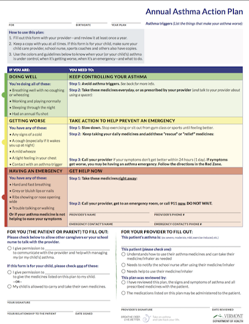School Nurses and Asthma
School Nurses are essential partners in helping students successfully manage their asthma. They play a key role in ensuring students with asthma have the knowledge and tools they need to effectively manage their asthma, particularly while at school.
Appropriately managing asthma in the school setting requires strong partnerships and team-based care. School staff, parents/guardians, medical providers, and students can work together to keep students healthy and in school. Local Health District Office staff are also available to partner with schools and providers to support their population health and system goals related to asthma.
School Nurses are often at the center of this network of partnerships aimed to provide effective support around each student.
This webpage is principally for School Nurses to offer a central repository for resources, tools, and tips to support their students with asthma.
Asthma in Vermont Schools
In Vermont, 1 in 14 children (7%) have asthma. This means that for every Vermont classroom with 30 students in it, two may have asthma. Furthermore, among children with asthma 52% report having uncontrolled asthma, putting them at risk of an asthma flare up that might disrupt their learning, require them to visit the School Nurses’ office and miss classroom time, or have a more serious asthma-related emergency.
Managing Asthma in Vermont Schools
Managing asthma in schools is important for a variety of reasons:
- Asthma is a leading cause of chronic disease-related missed school days.
- Asthma causes activity limitation and sleep disruption, impacting a student’s ability to concentrate, learn and engage in school activities.
- Asthma can be life-threatening.
With the right medications, reduced environmental triggers, and education on self-management, asthma can be managed.
School Nurses support students with asthma, as they similarly do with other conditions and needs, by:
- Coordinating with medical providers to ensure students have an updated asthma action plan, requesting appropriate consent to share forms between the clinic and school, and understanding permissions for each student to self-carry and self-administer their asthma inhaler.
- Supporting students in self-managing their asthma so it is well controlled, supporting them to participate in classroom and extracurricular activities.
- Administering asthma medications for younger children and those needing extra support.
- Responding and assisting a student with worsening asthma symptoms
- Communicating with families about understanding the student’s asthma action plan, notifying them when a student’s asthma symptoms are increasing, and ensuring all required paperwork is complete.
- Providing appropriate emergency care, if needed.



